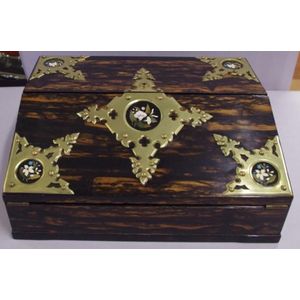Victorian Writing Box with Pietra Dura Panels
You must be a subscriber, and be logged in to view price and dealer details.
Subscribe Now to view actual auction price for this item
When you subscribe, you have the option of setting the currency in which to display prices to $Au, $US, $NZ or Stg.
- Victorian Period - The Victorian period of furniture and decorative arts design covers the reign of Queen Victoria from 1837 to 1901. There was not one dominant style of furniture in the Victorian period. Designers used and modified many historical styles such as Gothic, Tudor, Elizabethan, English Rococo, Neoclassical and others, although use of some styles, such as English Rococo and Gothic tended to dominate the furniture manufacture of the period.
The Victorian period was preceded by the Regency and William IV periods, and followed by the Edwardian period, named for Edward VII (1841 ? 1910) who was King of the United Kingdom and the British Dominions and Emperor of India for the brief period from 1901 until his death in 1910. - Pietra Dura / Florentine Mosaic - Pietre dura, also known in English as "Florentine mosaic" is a decorative art that originated in Renaissance Italy and involves the creation of intricate, multi-layered inlaid designs using a variety of different coloured stones. The name "pietre dura" is Italian for "hard stones," and refers to the use of hard, durable materials such as marble, agate, jasper, and other semiprecious stones in the creation of the designs.
The origin of pietre dura can be traced back to ancient Rome, where the technique was used to create intricate inlaid designs for mosaic floors, walls, and other architectural elements. During the Renaissance, the technique was revitalized in Italy and became particularly associated with the city of Florence. The court of the Grand Duke of Tuscany, Cosimo I de' Medici, was a major patron of pietre dura and employed many of the leading artists and craftsmen of the time to create a wide range of objects, from small items like jewelry boxes and vases to large panels and furniture.
In the 19th century, pietre dura was used to create a wide range of decorative objects, from furniture and decorative panels to small items like jewelry boxes, vases, and picture frames. During this time, the technique was particularly popular in Europe, where it was used to create elaborate pieces of furniture and other decorative objects for the wealthy and aristocratic classes.
In addition to traditional pietre dura objects like cabinets, tables, and vases, the 19th century saw the development of new forms of pietre dura, such as book covers, cigar boxes, and other small items. This was largely due to the advent of new, more affordable production techniques and materials, which allowed for the creation of pietre dura objects on a larger scale and at a lower cost. - Calamander / Coromandel - Calamander wood, also known as coromandel wood or coromandel ebony, is a type of hardwood that comes from the Calamander tree (Diospyros quaesita), which is native to Sri Lanka, India, and Southeast Asia. The wood is known for its dark brown or black colour and its distinctive figuring, which can resemble a snakeskin pattern.
The wood is highly prized for its beauty and durability. It is often used in fine furniture making, particularly in the production of inlaid and marquetry work, as well as in the making of boxes, cabinets, and other decorative items. It is also used in the manufacture of flooring, paneling and other architectural applications.
Calamander wood is a very hard and heavy wood, it has a density of around 1.04 g/cm3. Its density and high natural oil content make it resistant to decay and insects, which is why it is a popular choice for outdoor furniture, flooring and other decorative items.
The wood is also used for turning and carving, but is difficult to work due to its high density and interlocking grain. However, it takes a high natural polish and has a beautiful lustre, which is why it is so sought after.
Due to the high demand and over-exploitation of the natural resources, the calamander tree is now a protected species, and the harvesting and export of the wood is heavily regulated.
This item has been included into following indexes:
Visually similar items

Crown Devon Fielding musical Coronation box, of rectangular form, decorated with portraits of George VI and Elizabeth, with God Save the King lyrics, surrounded by a border of flowers, length 21 cm

A hardstone inlaid hardwood portable chest, Guanpixiang, the domed cover with ruyi -head metal fittings, above a pair of doors opening to reveal two pairs of short and one long drawer, the sides set with bail handles and a chain joining the cover and side,

Vintage oriental boxed Mahjong set 5 drawer, with tiles and sticks

An embellished hardwood portable chest, Guanpixiang, 19th/20th century the wood probably huanghuali, of square form, the flat topped hinged cover with metal ruyi -head clasp and corner mounts, lifting to reveal a shallow compartment over a pair of panelled
